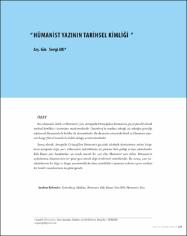| dc.date.accessioned | 2020-06-19T12:11:27Z | |
| dc.date.available | 2020-06-19T12:11:27Z | |
| dc.date.issued | 2015 | en_US |
| dc.identifier.citation | Arı, S. (2012). Hümanist yazının tarihsel kimliği. Sanat ve Tasarım Dergisi, 5 (2), 135-156. | en_US |
| dc.identifier.issn | 2146-7692 | |
| dc.identifier.uri | https://hdl.handle.net/11421/23409 | |
| dc.description.abstract | Bu çalışmada Gotik ve Hümanist yazı, Avrupa’da Ortaçağ’dan Rönesans’a geçişe paralel olarak
tarihsel kimlikleri üzerinden incelenmektedir. Gutenberg’in matbaa tekniği, bu tekniğin getirdiği
toplumsal dönüşümlerle birlikte ele alınmaktadır. Bu dönüşüm sürecinde Gotik ve Hümanist yazının hangi fikirsel temellerle ilişkili olduğu araştırılmaktadır.
Sonuç olarak, Avrupa’da Ortaçağ’dan Rönesans’a geçişteki ideolojik dönüşümün, yalnız kitapların içeriğinde değil, yazı stillerindeki farklılıklarda da görünür hale geldiği ortaya çıkmaktadır.
Eski Biçem yazı karakterleri içerisinde önemli bir yeri olan Hümanist yazı stilini, Rönesans’ın
aydınlanma düşüncesinin bir göstergesi olarak değerlendirmek mümkündür. Bu sonuç, yazı karakterlerinin bir bilgi ve duygu yansıtmakla beraber, üretildikleri zamanın ruhunu içeren tarihsel
bir kimlik taşıdıklarının da göstergesidir. | en_US |
| dc.description.abstract | In this study, Gothic and Humanist typefaces are explored in parallel with transition from the
Dark Ages to the Renaissance in Europe. Gutenberg’s printing techniques are discussed together
with social transformations brought by this technique. Intellectual foundations of Gothic and Humanist typefaces in this period are being investigated.
As a result, it is evident that the ideological transformation from the Dark Ages to the Renaissance became visible not only in literature but also in different typeface styles. It is possible to
consider Humanist typeface as an indicator of Renaissance enlightenment in addition of having an
important place in Old Style Typefaces. These result indicates that the typefaces have the historical
function of carrying the spirit of the time along with representing information and emotions. | en_US |
| dc.language.iso | tur | en_US |
| dc.publisher | Anadolu Üniversitesi | en_US |
| dc.rights | info:eu-repo/semantics/openAccess | en_US |
| dc.subject | Gutenberg | en_US |
| dc.subject | Matbaa | en_US |
| dc.subject | Rönesans | en_US |
| dc.subject | Eski Biçem Yazı Stili | en_US |
| dc.subject | Hümanist Yazı | en_US |
| dc.subject | Gutenberg | en_US |
| dc.subject | Press | en_US |
| dc.subject | The Renaissance | en_US |
| dc.subject | Old Style Typefaces | en_US |
| dc.subject | Humanist Typeface | en_US |
| dc.title | Hümanist yazının tarihsel kimliği | en_US |
| dc.title.alternative | Historical identity of humanist typeface | en_US |
| dc.type | article | en_US |
| dc.relation.journal | Sanat ve Tasarım Dergisi | en_US |
| dc.contributor.department | Anadolu Üniversitesi, Güzel Sanatlar Fakültesi, Grafik Bölümü | en_US |
| dc.identifier.volume | 5 | en_US |
| dc.identifier.issue | 2 | en_US |
| dc.identifier.startpage | 135 | en_US |
| dc.identifier.endpage | 156 | en_US |
| dc.relation.publicationcategory | Makale - Ulusal Hakemli Dergi - Kurum Öğretim Elemanı | en_US |
| dc.contributor.institutionauthor | Arı, Sevgi | |


















